Sugarcane, pirates and slaves
Raynol was a handsome young guy with his cool top knot hair style and easy-going manner who didn’t speak a single word of English but drove a bright yellow modern car which doubled as a taxi. We met him on the streets of Havana and negotiated a price for him to chauffeur us down to Trinidad on the south coast of the island and back to the airport over a three-day period. And so it was that we drove out of Havana early on the Saturday morning, Julie and I excited to explore new places in this fascinating but complex country.
Cuba is a country of 11 million people, perhaps the last country in the world that practices an extreme cradle to grave socialist model. Using a very broad brush, most people work for the government and are paid a low flat salary with only a modest difference depending on their job. Based on a couple of people we spoke to, the average salary in Cuba is about $20 to $30 per month, including professional roles like doctors, but people do not have to pay for education, medicine, transport, housing, etc. They must buy their consumables like food and clothes – food in particular is at highly subsided prices – but basically the government looks after them in most ways.
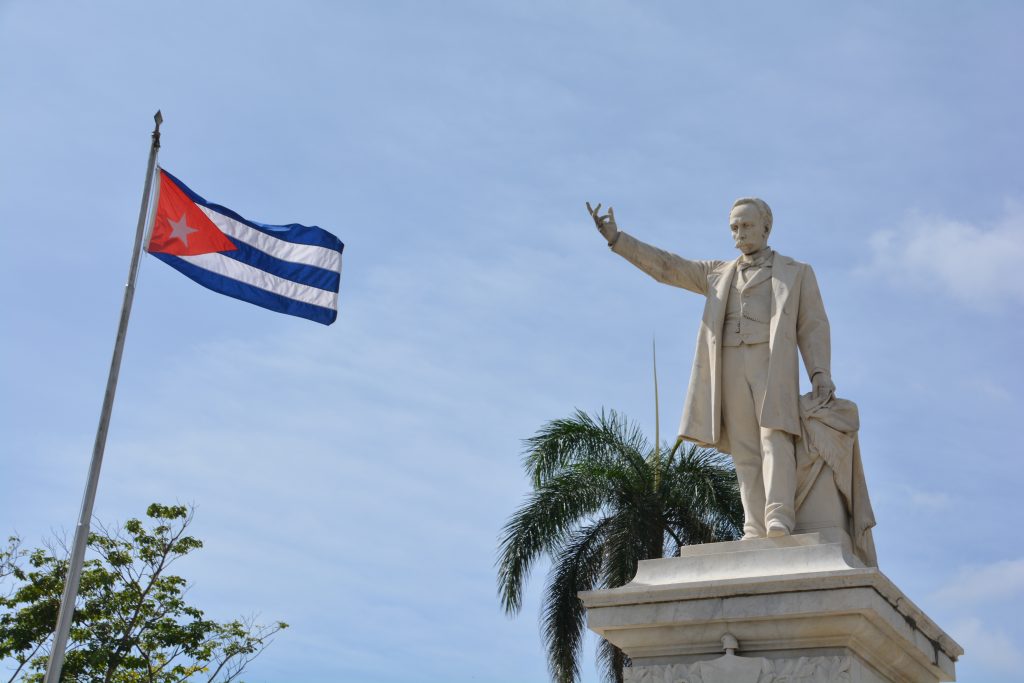
Cuba’s hero from their war for independence with Spain, Jose Marti, proudly points to the Cuban flag
Its not a world that encourages hard work, entrepreneurship or individual success but everyone gets by. Private ownership of things like cars and homes is very rare but in recent years it has been possible to sell these assets. We were told that Cuba is slowly evolving, more commercial activities are being allowed, more international trade is happening, but the government is careful that such changes don’t happen too fast and that they stay in control of all activities. And of course Cuba lies smack dab in the middle of the Caribbean with glorious warm weather and rich fertile soil.
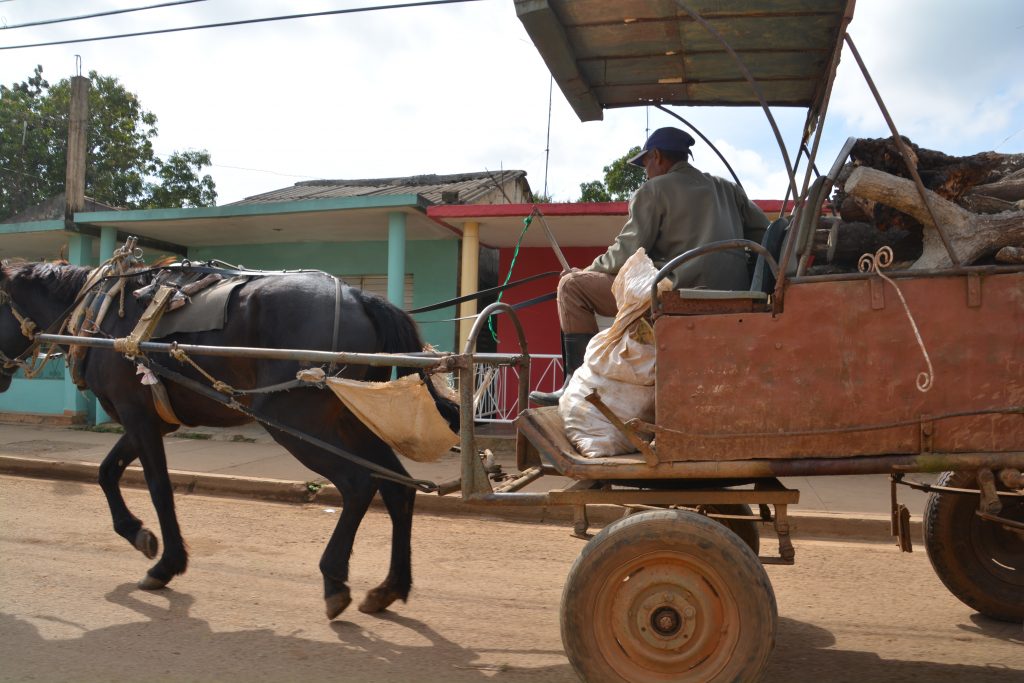
We didn’t expect this – travelling through rural communities in Cuba means sharing the road with horse drawn carriages
We headed east out of Cuba on the country’s only highway, or autopista, which started out as a huge eight lane highway with almost no cars on it. This was a theme we first noticed in Havana – big roads in poor condition with no traffic. Go figure.
The land was flat and green with only occasional development, perhaps some crops, at other times cattle were grazing, occasionally a stretch of jungle but mostly undeveloped land, sometimes land that had been cleared years ago and left to go fallow. There were no towns on the highway, rarely any signs of activity in any way and almost no traffic. Raynol expertly used all available lanes to weave around the endless battleground of pot holes and broken road.
We left the highway and started using narrow secondary roads on our way to the historic town of Cienfuegos. The drive became much more interesting, passing through small towns, an endless stream of people using different forms of transport to get about, sugarcane growing almost continuously on both sides and all sorts of traffic on the road.
There were public buses and trucks which people could flag down and jump on, there were old classic cars from the 50’s and 60’s which were used as local communal taxis, three wheeled motorised bikes carrying people and goods, motorbikes, bicycles, a few cars and most remarkably – horse drawn buggies. Single horses pulled buggies to carry people, even as a local taxi service, or flat bed trays to carry goods, or even a combination for people and goods.
These horse and carriages were everywhere, usually four wheels but occasionally only two wheels, walking or trotting on the pavement or on the wide dirt shoulder if available. Astounding time-warp stuff, just amazing. And on top of that we also saw a few flat bed trays pulled by two large bullocks, true beasts of burden.
We also loved the cowboys, or vaqueros, riding their horses with their huge hats on, down main streets, out rounding up cattle, on the side of the road heading somewhere. Hollywood was nowhere in sight – this was all the real deal.
Raynol took us into the large regional centre of Cienfuegos, known for its colonial buildings, and we parked on the main square to explore some of the grand colonial buildings and climb up one of their towers to get broader views of the city. We then drove down to the waterfront to the historical building at the end of the esplanade called La Punta and climbed its tower for expansive views of the bay which Cienfuegos sits on. The place had a very good feel to it and deserved more time but we needed to move on and followed the coast the final 80 kilometres to the historic town of Trinidad.
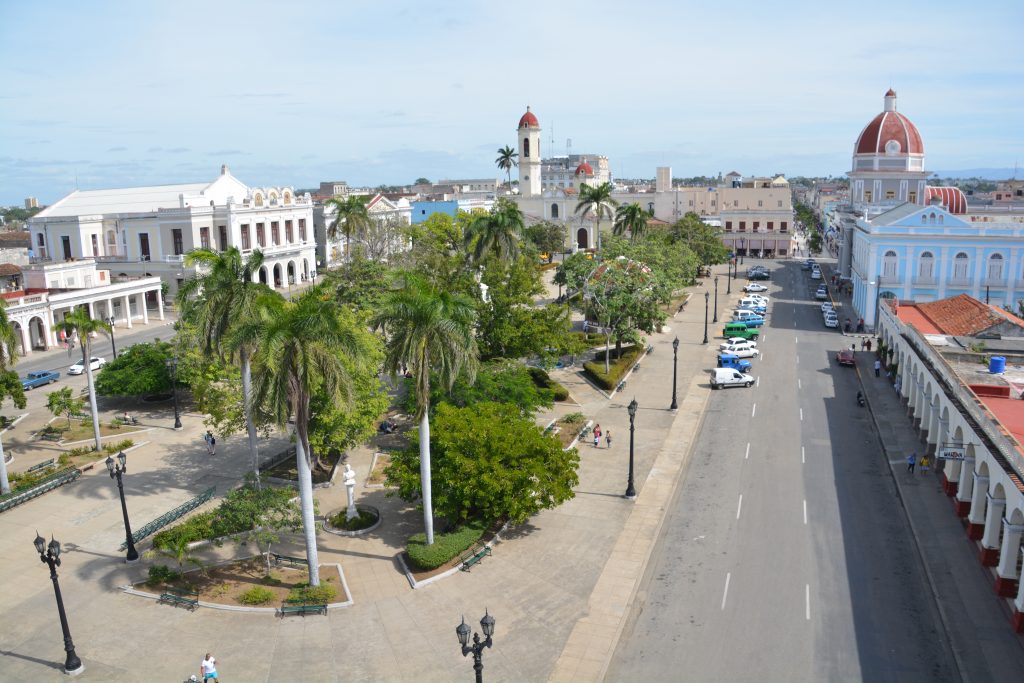
The Spaniards were great at constructing fabulous buildings and plazas but also specialised in towers which are now very handy to climb and get a view of the place
Cuba was settled by the Spanish at the beginning of the 16th century when they recognised the island as being in the trade routes between the new and old world, having good soil and climate for growing crops and safe harbours.
The city of Trinidad on the south coast of the island grew as a centre for the lucrative sugarcane industry which was developed by wealthy Spaniards who harvested and processed the cane in more than 40 sugar mills in the area with the help of African slaves they brought in from the distant shores of west Africa. Pirates also found these shores lucrative and raided the city many times over the years. What a place it must have been to live in those boomtime days!
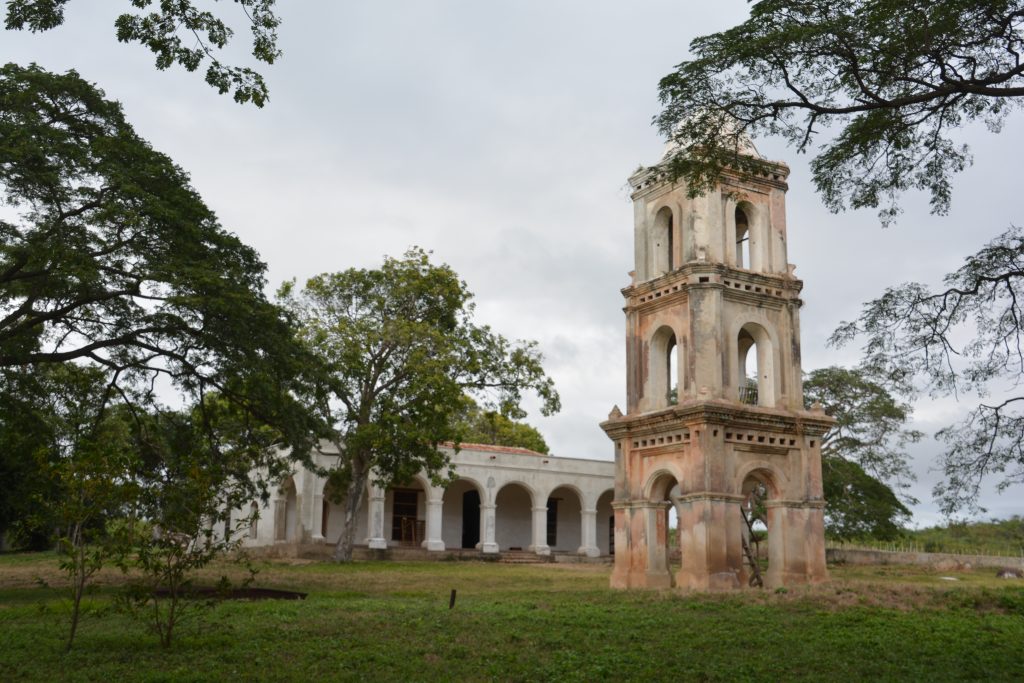
We visited one of the old sugar cane plantations – you can still get a feel for what it might have been like in those days
The historic centre of Trinidad has been preserved much as it must have been in those heady days with its rough cobblestone streets and narrow lanes, beautiful old buildings painted in bright colours and a series of old colonial buildings turned into museums to highlight the city’s colourful history and the contribution it made to both Cuba and the entire region.
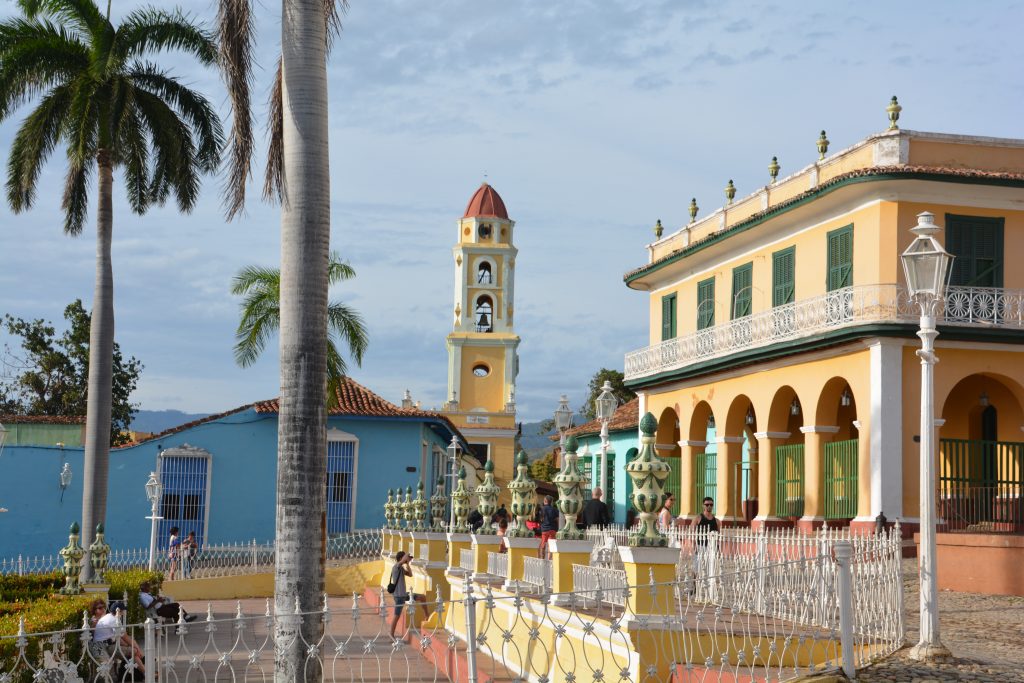
Trinidad had it all – grand historic buildings, old cobblestone streets, bright colours everywhere and a couple of towers to climb
Raynol had a heck of a time finding our little hostel on a steep one lane road in the centre of the old town but we quickly settled in, said a temporary goodbye to him, and then began to explore the town. And what great fun it was, as long as you were careful not to break an ankle on the uneven cobblestone and you didn’t mind pulsating Cuban music emanating from every little bar and restaurant in town.
Like many colonial towns, the Cathedral marks the centre of town and from there we ventured out to climb one tower that featured huge church bells and another tower in one of the old Spanish sugarcane baron’s homes that was used to key an eye for any unwanted ships coming into port. We had a drink in the main square while absorbing the buzzing atmosphere of travellers, live music and this fabulous historic town. Dinner that night was on a roof top terrace, seafood, rum, a warm breeze and great views. Oh yeah!
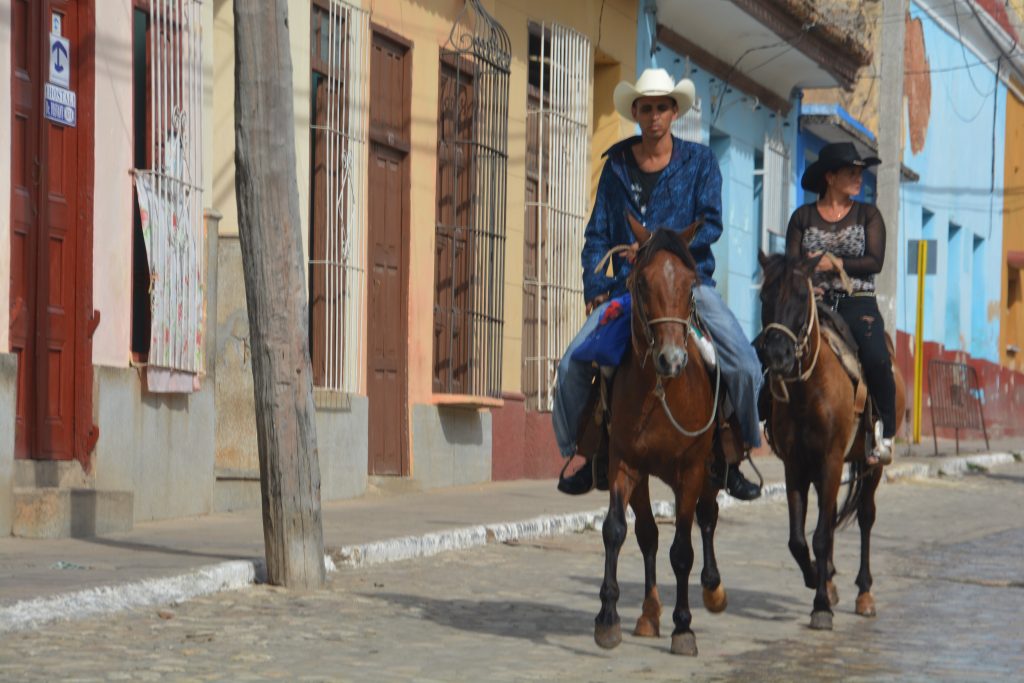
This is not a movie scene – we saw this sort of thing repeatedly in Trinidad, just locals going about their business
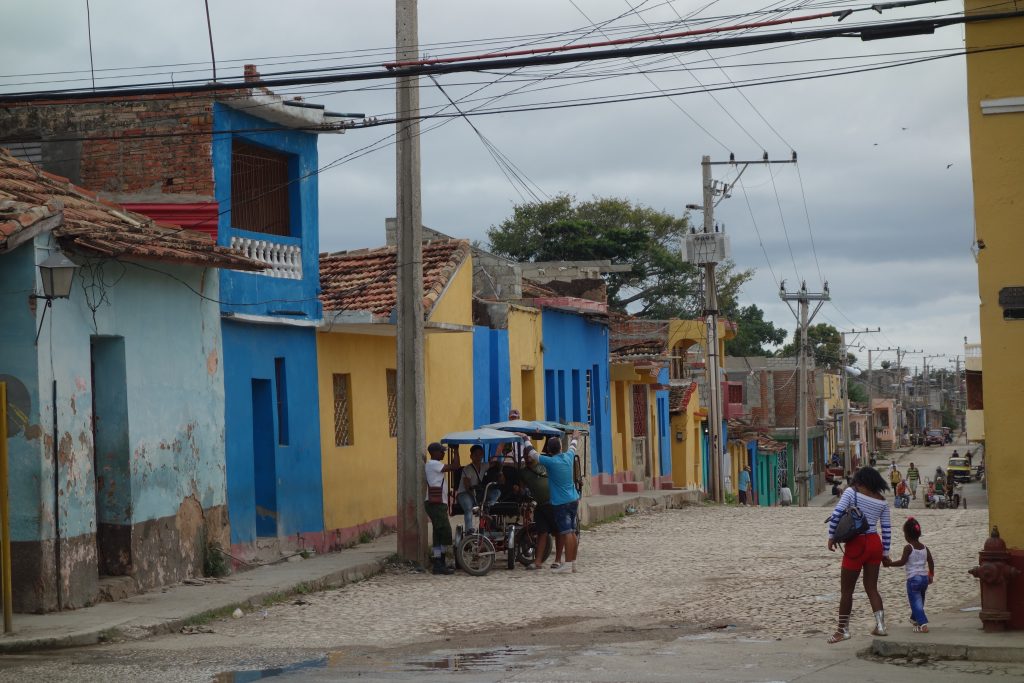
You gotta love the colours of these buildings – most of them are kept freshly painted despite the hard life people live
But Trinidad and its surrounding area had much more to offer so we spent the next morning exploring it narrow cobblestone streets lined with buildings that were up to 400 years old and enjoyed time watching the world pass by from benches in the shaded parks. We hired a local driver in the afternoon who took us out of town to visit some of the old sugarcane plantations, including a climb up the highest tower in Cuba – used to keep an eye out for any possible runaway slaves. All great stuff.
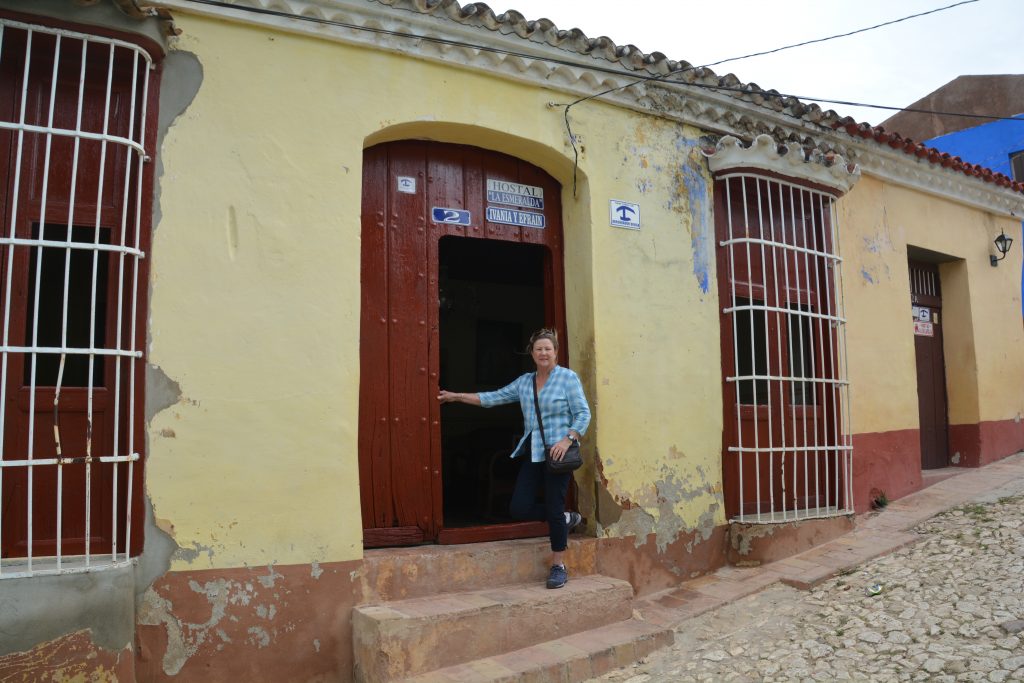
Julie at the front door of our B&B-type accommodation. This family had converted their home by adding a couple of bedrooms and served us breakfast – all very clean and friendly
The next morning we reluctantly left our cosy little homestay B&B that was perfectly placed around the corner from the main square and Raynol drove us back up through the beautiful Cuban countryside to the airport where we jumped on our flight back to Cancun. Parting was indeed sweet sorrow.
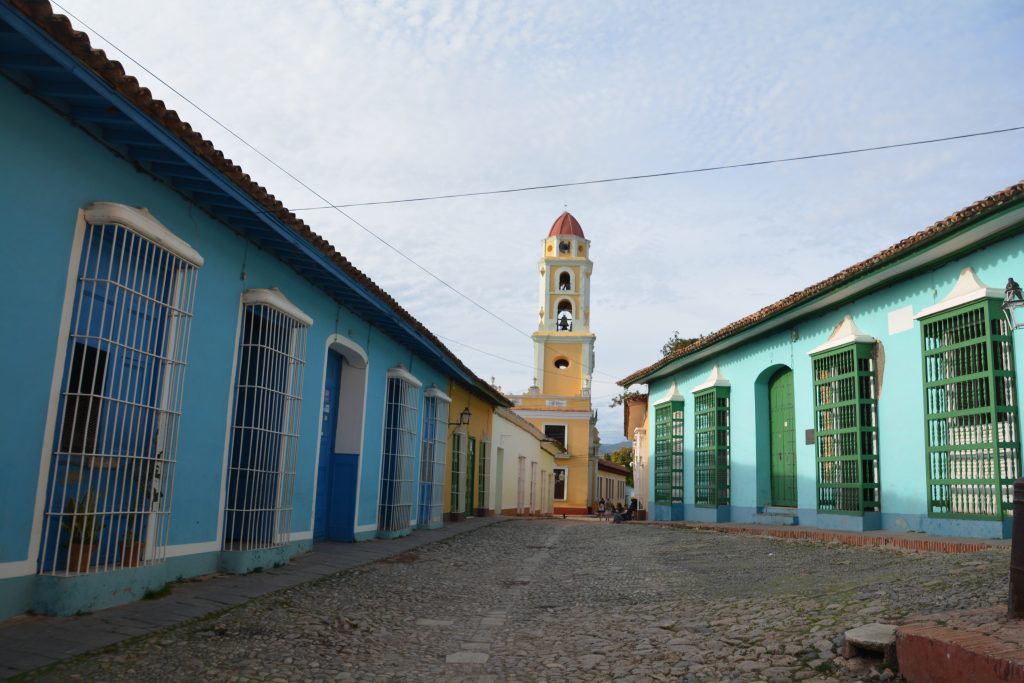
These buildings typically had small doors behind the grills but opened up into courtyards which would be cool in the summer heat
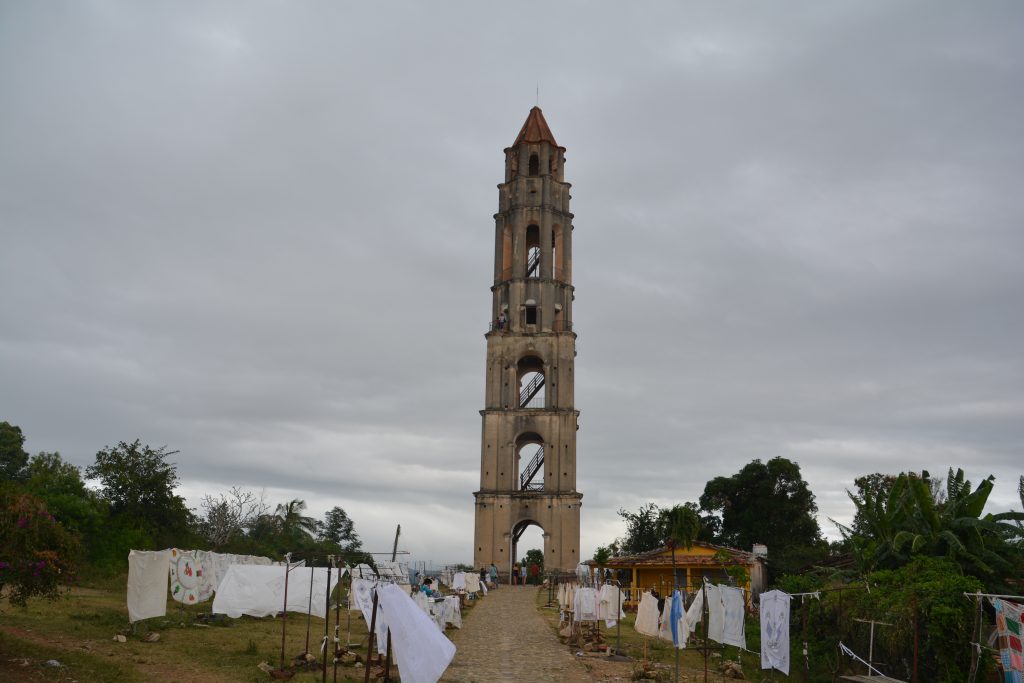
The highest colonial tower in Cuba was built at this old sugar cane plantation to keep an eye on slaves so they wouldn’t escape. Today the locals sell beautiful hand made tablecloths…and Julie supported the local artisans
A couple of final observations about Cuba. First of all, if you ever get a chance to go – JUST DO IT! Old Havana is a wonderful place to explore, either by foot or by a 1953 perfectly restored Chevy, it has a fascinating history, wonderful architecture and a complex but intriguing political history. Most of the people are super-friendly and welcoming, the weather is superb and the mojitos, pina coladas and/or Cuba libres are great. Trinidad is all that but throw in the super cane industry, slavery, pirates and cobblestone streets for a bonus.
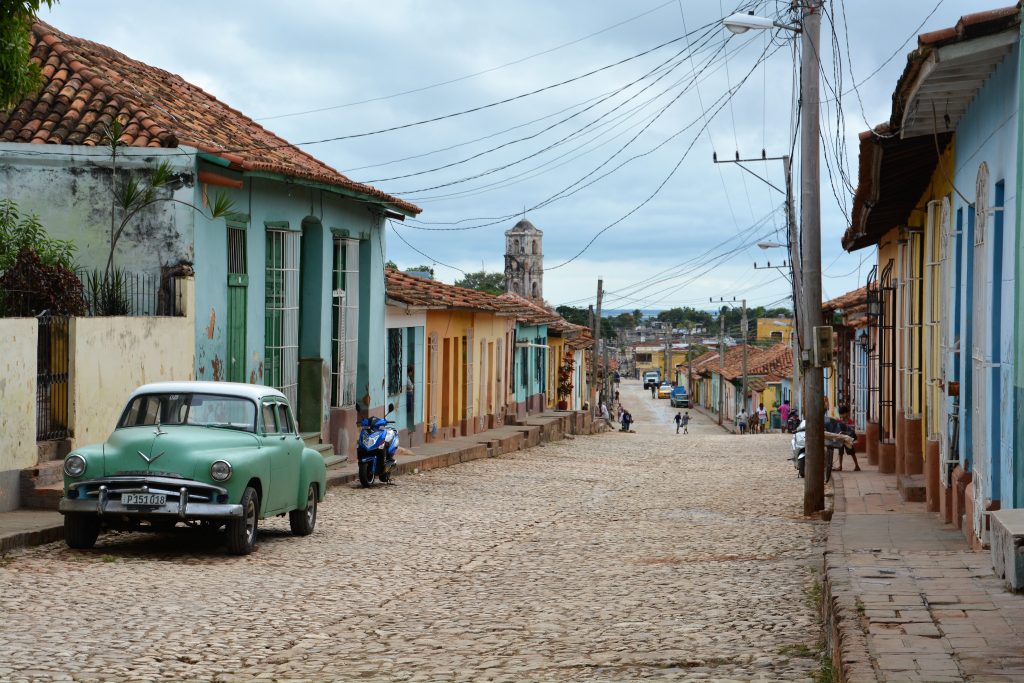
Plenty of colour but not much movement – the streets of Trinidad were usually fairly quiet as there is very little traffic
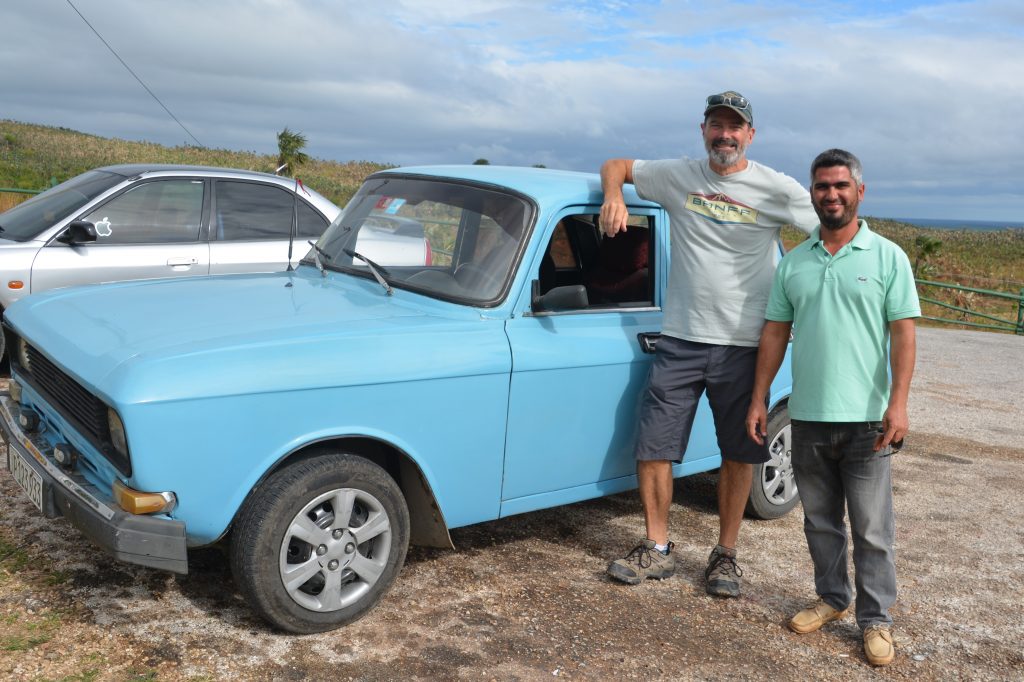
We hired a local driver who said his name was O’Neil and spoke good English. He took us to some local sites and explained in more detail how Cuba is slowly and carefully moving to a new economic model but they are way behind the rest of the world and face many challenges
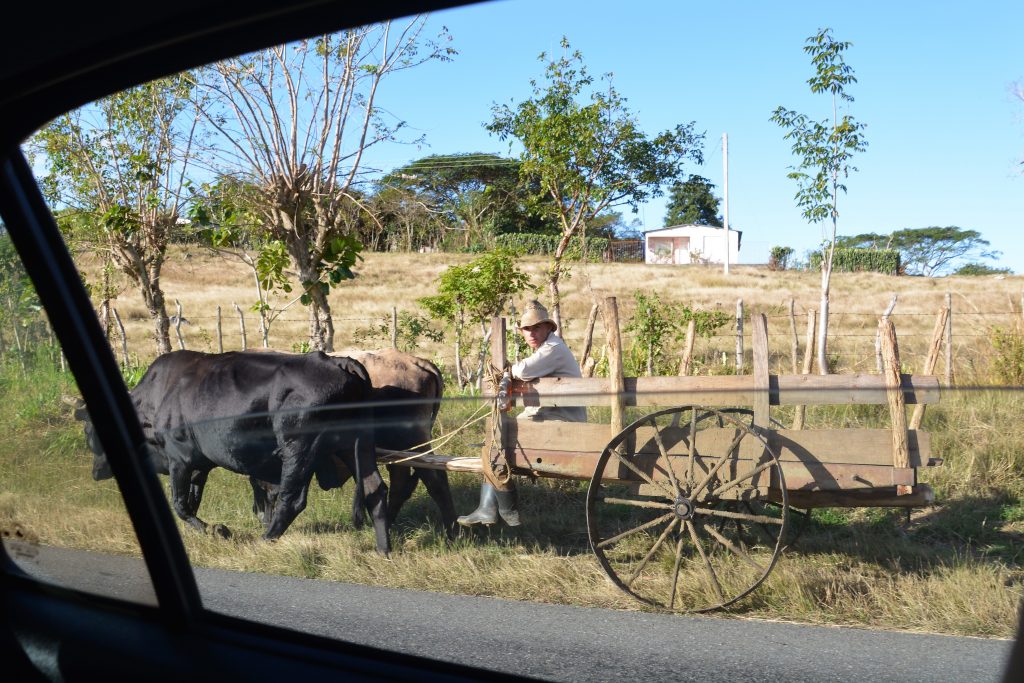
A quick shot through a car window reveals an old cart with medal wheels being pulled by two bullocks – amazing stuff
We drove 800 kilometres in Cuba without a single police or military roadblock, saw absolutely no military presence at all, never felt threatened or at risk in any way and found the people to be wonderful. Yes, there’s a few little unsophisticated scams going around that any savvy traveller will see through but that’s normal almost anywhere. Cuba seems incredibly safe.

Unbelievable stuff – a steer was wandering out on the road and the cowboy lassoed him in front of us and pulled him off the road
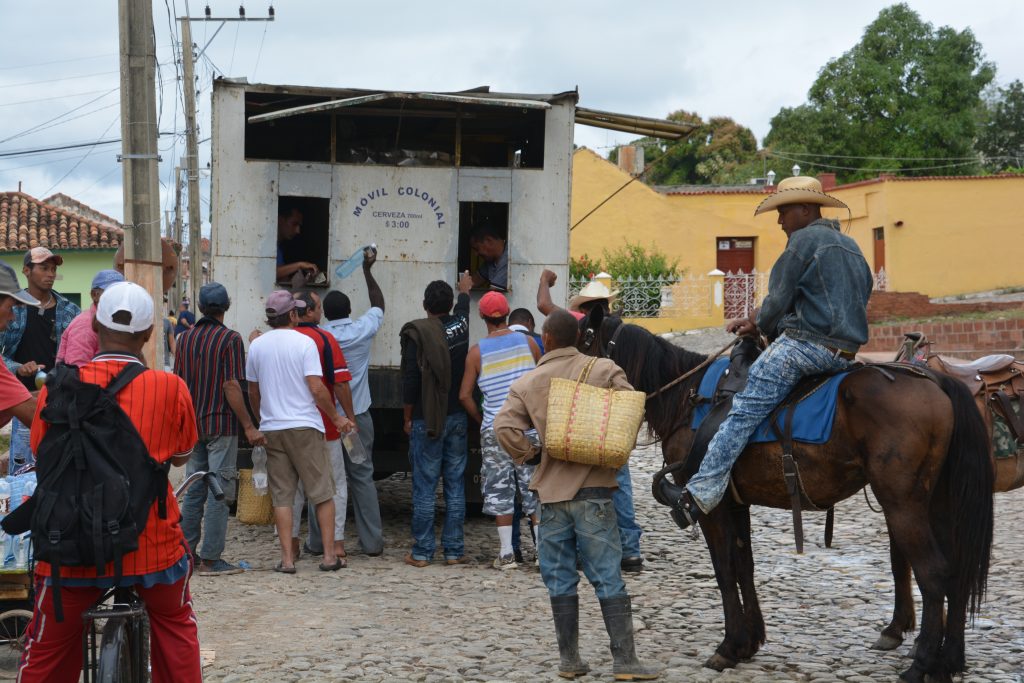
We came across this roving beer truck – people bring their large plastic bottles and hand them through the window where the guy will fill it up for only $3 in the local currency…about 12 cents
We saw a few recurring themes such as men smoking cigars at any time (our host one morning served us omelettes with one hand while holding a cigar in the other), images of Fidel and Che everywhere, especially on tourist T-shirts, we heard and saw live music in almost every bar and restaurant, lively Cuban salsa or sometimes a more bongo-drum African sound but all beautiful, we loved the horse-drawn buggies with all their variations performing so many important functions for rural Cuba and we marvelled at how Cuban women dressed – super-tight synthetic clothes no matter what size, shape, age or colour the woman might be. Cuban women are generally BIG and let it all hang out in a colourful and unabashed way – wow! In fact, you might say that about all of Cuba, a memorable experience for both of us.
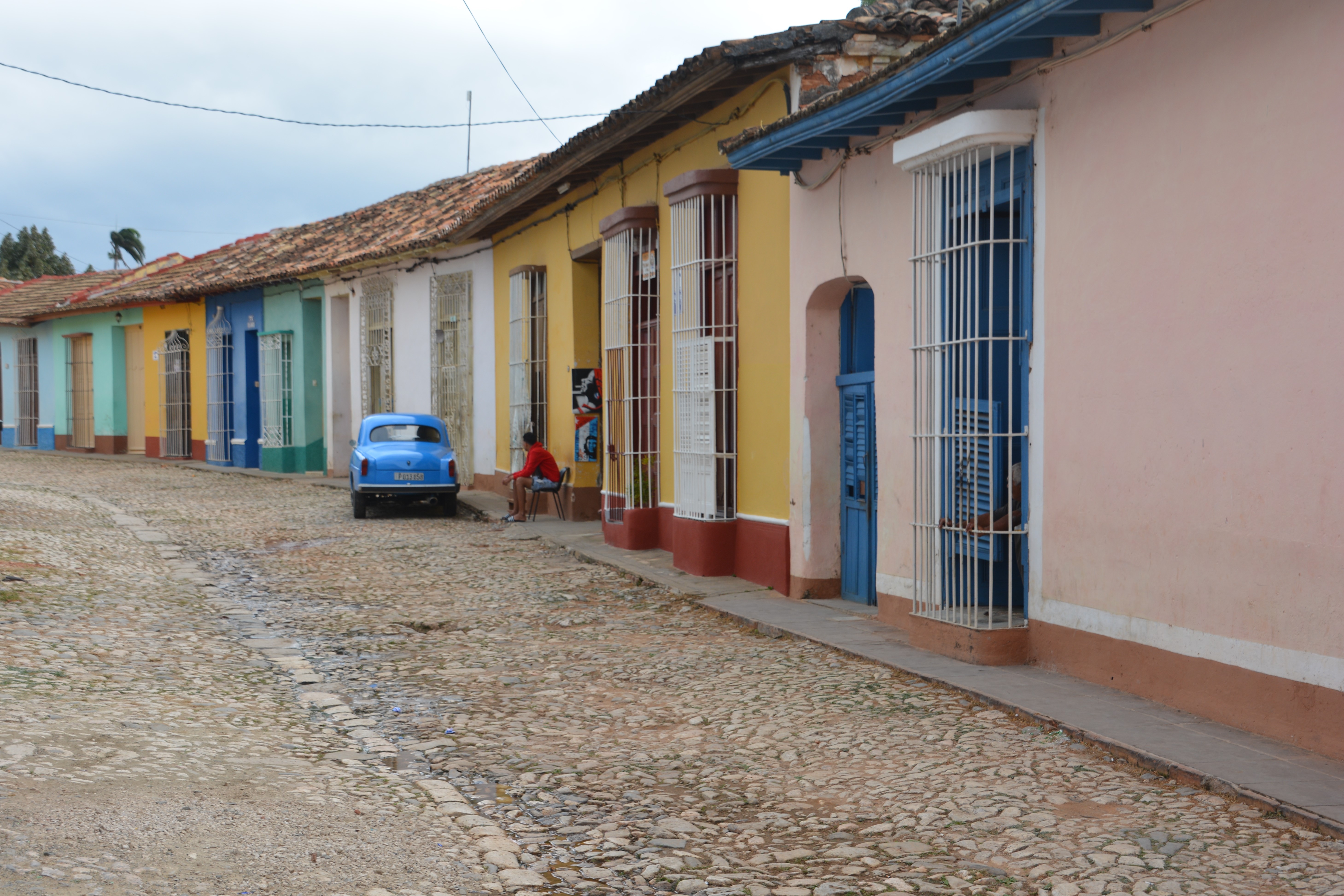











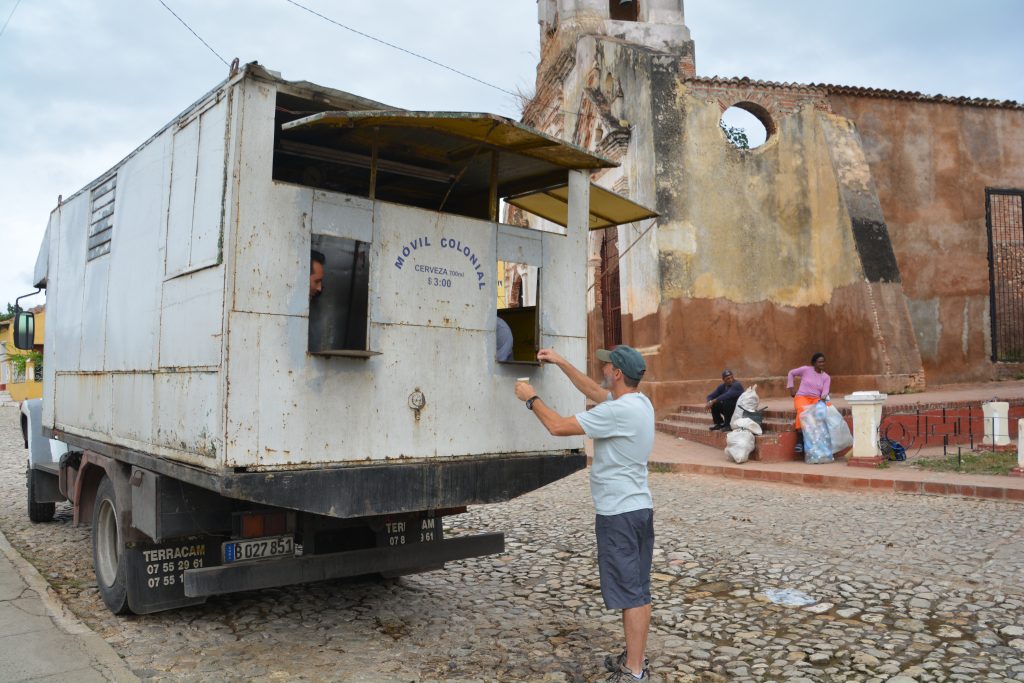



This is just fascinating- what an amazing place
Hi Deb, good to hear from you. We have to admit we gained a certain soft spot for the Cuban people during our stay. They were warm, friendly and generous to us at every turn but still in a very difficult situation. Here’s to hoping their circumstances improve in the years ahead.
Bill
Raynol’s cool top knot would be known these days in the USA as a man-bun. That makes it okay for the macho type to sport.
Hi Linda. Whatever you call it I’m just jealous because its been 30 years since I could have done anything like it! Bill